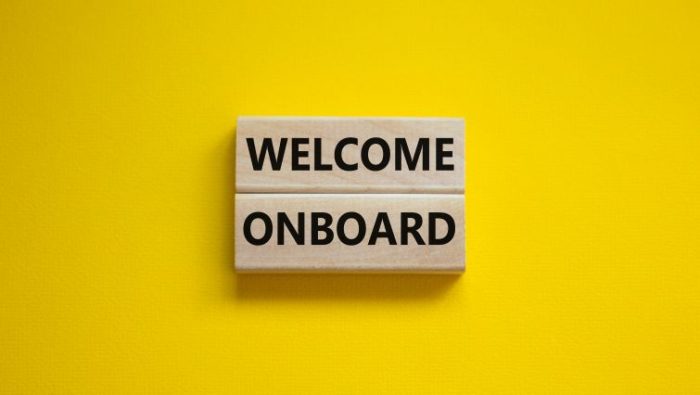4 Crucial Phases of Employee Onboarding
 Publié le 3 October 2022
Publié le 3 October 2022
Ensure that a new hire successfully joins the workforce by understanding 4 crucial phases of employee onboarding.
A successful onboarding process means less stress for your new employee and less hassle for your existing teams. That’s why you should ensure that your onboarding process is as detailed and painless as possible.
We will look at four crucial phases of employee onboarding that should make up an organization’s process and how they can help develop well-integrated new hires, leading to better business performance.
What Is Employee Onboarding?
Employee onboarding is the process of integrating new hires into your organization. It allows you to make the perfect introduction to a new employee, laying out all that you expect from them and helping them fit seamlessly into their new role. This is when you provide them the training and lessons they need to excel in their new role, helping the work team meet important goals.
Onboarding covers all aspects of the new-hire orientation process. It can include various activities designed to help new employees learn about the organization they are joining, including its structure, culture, values, and mission.
The employee onboarding process can be split into phases to provide a more structured experience. Each phase focuses on a different aspect of the employee’s integration, allowing them to learn all they need to know without overwhelming them with too much information all at once.
Why Is Employee Onboarding So Important?
Think about the last time you started a new job. You probably had a million and one questions to ask about your new role. The employee onboarding process answers all these questions and more, ensuring that new hires know what expectations they need to meet, what processes they should follow, and how well they will fit into the organization’s culture.
(One of the top reasons employees say they leave a role within six months is that they didn’t receive clear guidelines about their responsibilities.)
A phased employee onboarding process has even more benefits. It allows for consistency across the onboarding process for new hires, so if you have taken on a lot of new employees at once, you can ensure they’re all meeting the necessary milestones simultaneously, and nobody is getting left behind.
It ensures that everybody in the organization knows exactly what stage of the process a new employee is in at any given time. This allows managers and other employees to focus on what is vital without overloading the new employee with information they may not need until they have been in the role a bit longer. (They probably won’t need to learn how to use the Microsoft Advertising Dashboard on their first day on the sales team, for example).
4 Crucial Phases of Employee Onboarding
The employee onboarding process can be divided into 4 crucial phases. Each will focus on a period leading up to and after the employees’ acceptance of the position. Each phase plays a crucial role in ensuring the new employee has a long and successful future within the organization.
4 Phases Of Employee Onboarding
- Pre-boarding
- Introductions
- Discovery
- Review
1. Pre-boarding: Before a New Employee Starts
The onboarding process should start before the employee’s first day in their new role. This pre-boarding phase helps the employee know what to expect when they begin working for the organization while simultaneously providing the organization with all the information they need about their new team member.
One of the most important tasks to take care of during pre-boarding is getting any necessary paperwork done. It can include signing official employment contracts and registering bank details so you can pay your new team member. Ensure to take this time to have the employee sign any non-disclosure agreements (NDAs) or anything else they should need to sign for official purposes.
The pre-boarding phase can also be a good time to set the employee up with any credentials they’ll need to access cloud computing systems or other company software. Ensuring that employees have access to all the programs and systems they need to do their job is vital to ensuring they have a strong start. It can also be used to set up their workstation in the office or deliver any equipment they’ll need to them if they’re working remotely.
A successful pre-boarding process is crucial as it ensures that once the employee begins work on their first day, they can focus on settling in, learning the job, and meeting their colleagues.
2. Introductions: Their First Week in the Job
Once an employee begins work on their first day, they move into the second phase of the employee onboarding process. This phase may last for a few days, a week, or possibly even longer in especially large organizations.
The main focus of phase two is to ensure that new employees know who they’re working with, and where to turn if they need support. For this reason, it’s arguably the most important phase in the onboarding process. The most successful workplaces are those with teams committed to communication, support and collaboration. By helping a new employee forge supportive bonds with their colleagues as soon as possible, they know that there is a whole team rooting for their success and are prepared to lend a helping hand.
Even if your employee is working remotely, this phase can be carried out effectively by using tools such as video chat or messaging apps. If your organization uses platforms like Slack, you’ll probably have already added your new employee to the relevant channels and chat rooms during pre-boarding, giving them a head start on phase two.
3. Discovery: Their First Month in the Job
The third phase is where employees expand their knowledge of their new job role and their place in the organization. They will already have a basic knowledge of their responsibilities, and the tools they need to complete them, from phases one and two, but now they can begin to sink their teeth into the role.
Phase three will often involve new hires being partnered up with a buddy or mentor so they have somebody to ask any questions they may have and can be shown the ins and outs of their role by somebody who knows it inside and out. If the new employee is to replace a person leaving the company, try to arrange some training between them before the employee’s departure date. Anyone who has specific knowledge of the role itself should be consulted regarding what needs to be taught and any obstacles which were encountered early in their employee onboarding process.
Setting milestones during phase three will help the employee and their employer see how much progress they have made and how well they’re settling in. This phase will often conclude with meetings between the employee and their manager, where they can be given feedback on their progress and set targets for the future.
4. Review: After Four to Eight Weeks in the Job and Beyond
The fourth and final phase of the onboarding process is the review phase, where employees will begin to focus more on independent work and putting to use what they have learned by assuming most of the key responsibilities that their role will entail going forward.
Regular check-ins and meetings will often occur during this phase to check the employee’s progress and ensure they’re getting everything they need. If they feel they need additional training in specific areas, company leaders should always encourage this and ensure that it can be arranged.
Performance checks will allow the employee to see how well they are performing and identify any areas in which they may need improvement, giving them a chance to train and practice so they can fulfill their duties going forward.
Phase four is usually the longest in the onboarding process and can last many months after the employee has started work. Onboarding can be (and should be) a lengthy process, despite over 50% of employers surveyed stating their onboarding process lasted one week or less.
A final onboarding check-in should be held with the employee once both parties feel they have grasped their new role. By making open and honest check-ins a regular part of the workplace culture, it will ensure that employees and managers are always on the same page regarding projects, expectations and goals.
Phased Onboarding Is the Way Forward
Following these 4 crucial phases of employee onboarding will help you get the most out of your new hires, ensuring they know their responsibilities and how to effectively use all the tools they will need to fulfill them.
Employee onboarding shouldn’t be a quick process; it takes as long as it takes. Rushing through the process will only result in employees that don’t feel confident in their role and can potentially lead to higher employee turnover rates.
Take your time to introduce your new hires to the teams they’ll be working with, who to ask if they have any questions, and let them know how well they are settling in at every chance you get. Both your employees and your business will perform all the better for it.







